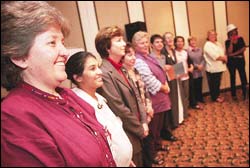Talking about a revolution
17 May 2004
Talking about a revolution: Transformation Through Occupation aims to change the way occupational therapists view their discipline.
First books are meant to be modest affairs.
But in Transformation Through Occupation, the first fully-fledged book to come out of UCT's Division of Occupational Therapy - there'd been one booklet before - the 18 authors, most with past or present ties to UCT, are aiming high. They want to revolutionise how their discipline is perceived and practised around the world.
The bulk of the book records the grassroots projects and research of UCT occupational therapists done with and in communities around South Africa. Nothing astounding in that, one would think. But the very fact that these projects were run in the communities themselves, rather than from advanced-but-inaccessible clinics and hospitals in leafy suburbs, makes the research and the work stand out from anything else done in the world.
With the looming retirement of Associate Professor Ruth Watson (now Emeritus Associate Professor), longstanding head of the division, at the end of 2002, there was some anxiety about what would happen to the section in the wake of Watson's departure. In particular, there were worries among staff and students that the philosophy that Watson - spearhead and guru - and others had tried to inculcate in students would be lost.
Under Watson's leadership, the division had developed an innovative approach to occupational therapy in South Africa, explains Professor Leslie Swartz, formerly of UCT but now of the University of Stellenbosch and the Human Sciences Research Council (HSRC). "They had taken the discipline and moved it from a solely clinical discipline, which focused on helping an individual with a particular pathology, to a more population-based discipline, which is much more appropriate for our context," he says. "It was an attempt to make the skills that occupational therapists have available to a much broader community with a much broader scope of practice, which is unusual and innovative in international practice."
Adds Associate Professor Lana van Niekerk, one of the book's contributors and Watson's successor as head of occupational therapy at UCT: "Professor Watson and many of us had started to reinterpret occupational therapy practice." The reinterpretation was based on the concept of "occupational justice", which decrees that people, be they adults at work or children at play, have a right to meaningful occupations. "If you go to the philosophical roots of the profession," comments Van Niekerk, "our interpretation is not about making symptoms better - it's about people being able to participate in work, in leisure, and being able to take care of themselves and their environments."
Through discussions with Swartz, initially sought out to help with staff development, it soon became clear that a book was on the cards. For the first time the text would commit the division's reinterpretation of the discipline to paper. Watson and Swartz would act as editors, it was agreed, while the students and staff would write up the research papers.
With Swartz regularly cracking the whip, the last i's were dotted and the final t's were crossed in the latter part of 2003. The first section covered the theoretical aspects of this new philosophy of occupational therapy, while the rest of the book, penned by the researchers, tackled topics such as the occupational struggles (work, domestic roles) of fathers with HIV/AIDS, how the very act of playing can influence the general health of children with HIV/AIDS, and psychiatric disability in the world of work.
This new model, believe the authors, has legs. Even wealthy first-world nations are no longer the homogenous entities they once were, reshaped by both the influx of migrants and refugees and the greater mobility associated with globalisation. Medical professionals in these countries now have to cope with large numbers of communities, similar to those in South Africa, who are unable to access the services of occupational therapists who, by and large, are still concentrated in hospitals and clinics. "People around the world are looking for models that are not rooted primarily in the United States or primarily in Europe," says Swartz.
And any qualms that the authors don't have the coalface facts or credentials to back up their theoretical claims are easily laid to rest, notes Van Niekerk. "Most of the book, in chapter after chapter after chapter, is about how people interpret occupational therapy practice through doing research and service at the same time. The theories were developed in practice."
Among those taken with the book is Emeritus Professor Betty Hasselkus of the University of Wisconsin-Madison in the US, who writes in her foreword that its message is no different from the message of occupational therapy that has been around for decades. "But the context of a developing country such as South Africa mandates a re-interpretation of the message - a reorientation toward community and populations in order to position occupational therapists to act as catalysts for social transformation," she says.
"This book is a gift to the profession of occupational therapy."
Contributors: Miriam Altman, Hilary Beeton, Kathleen Brodrick, Helen Buchanan, Lizahn Cloete, Zelda Coetzee, Madeleine Duncan, Marion Fourie, Roshan Galvaan, Dr Craig Higson-Smith, Kashifa Lagerdien, Theresa Lorenzo, Elelwani Ramugondo, Dr Linda Richter, Prof Leslie Swartz, Assoc Prof Lana van Niekerk, Emer Prof Ruth Watson, Karin Weskamp.
 This work is licensed under a Creative Commons Attribution-NoDerivatives 4.0 International License.
This work is licensed under a Creative Commons Attribution-NoDerivatives 4.0 International License.
Please view the republishing articles page for more information.










